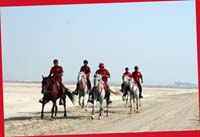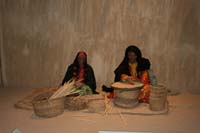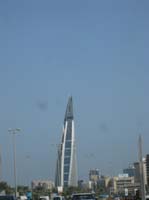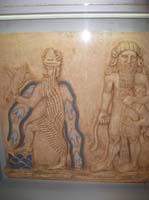Galleries:Royal Stable & Training RideJohn's Tourist photos Steph's Tourist photos refresh browser to view different images: Bahrain Royal Stables Images by Steph Teeter        Bahrain Tourists Images by Steph Teeter       Bahrain Tourists Images by John Teeter       A Visit to BahrainI had a general idea where Bahrain was, having touched down at the Bahrain airport a few times on the way to Abu Dhabi, but other than that I knew very little about this small country. John and I were invited to come and visit for a few days after the Malaysia WEC - to be introduced to their Endurance program. Tawfiq Salehi, the head of the Media & Information Center for HH Shaikh Nasser bin Hamad Al Khalifa arranged the trip for us. We had met Tawfiq and a few others from the media and the Royal Stables at previous events, and had been trying to get over there for a while. The invitation was extended, the timing was perfect, so we juggled our plane reservations and made the trip. The only other Middle Eastern country I had been to previously was UAE - United Arab Emirates. (I've been to Egypt, but I'm not sure whether it is technically Middle East, or North Africa...) (and we were in Oman once but only for a few hours when we accidently crossed the border while driving through the wadi's with Grace and Madiya). I assumed Bahrain would be more traditional - less 'westernized' than UAE, and thought it might be like UAE was ten years ago. But, what a surprise! This is a very modern country. Bahrain means 'two seas'. It is actually a group of islands off the coast of Saudi Arabia, at the mouth of the Persian Gulf - a strategic location, which was contested by many nations and peoples over the past centuries. It was most recently wrested from the Persians in the 1800's by the Al Khalifa family who came from the Arabian mainland (Saudi) . The island nation later became a British protectorate and finally gained independence in 1971. With the discovery of oil, the nation prospered and the Al Khalifa family gradually moved Bahrain into the circle of modern finances and culture. The skyline of Manama, the capital of Bahrain, is graced with high-rise buildings and modern architecture. A classic feature of the skyline is a sweeping building of chrome and green glass, suggestive of a wave, with 3 huge wind turbines built into the structure's center - designed (by Norman Foster) to compliment the seascape and capture the wind energy from the ocean. Several of the islands that make up the Kingdom of Bahrain are connected by bridges, and there is also a bridge connecting Bahrain to Saudi Arabia. Bahrain has become a haven for many Saudi's - a place where they can come to escape the restrictions of their own government and enjoy a more moderate atmosphere. The Saudi's have also invested a lot of wealth in businesses, buildings and banks (Bahrain is a major world banking center). The countries of the GCC (Gulf Cooperation Council) enjoy unrestricted trade among themselves, so there is little to inhibit development in neighboring countries. This has contributed considerably to Bahrain's growth and status. There are plans to build a suspension bridge between Bahrain and Qatar which will also increase the flow of business and greatly increase Bahrain's accessibility. Bahrain also has a Free Trade Agreement with the United States. They are very open and friendly to westerners in general. We were met at the airport by Yusef - no English spoken, but he recognized the tall Americans and led us to the baggage claim, and then outside where we were handed over to 'Driver' a very tall, soft spoken Bahraini who also spoke very little English, but had a ready smile and drove a Mercedes with special (Royal) license plates and had a very confident and protective air about him - and he tried really hard to understand our friendly chatter. We were taken to the Bahrain Sheraton - where it hardly even felt like we were in a foreign country - English spoken by all, catering to business people and visitors. Driver saw that we were checked in and then said he'd pick us up at 'Ten and a Half' the next morning. Ok then! After breakfast, and a chance to work a little (internet in the room - still finishing up from Malaysia) we met Driver downstairs and hopped into his Mercedes and off we went - to somewhere. It was great to go for a drive in the daylight - past the tall buildings, along the seashore and corniche, past tons of new construction, some quarries (aluminum is also a major export), neighborhoods, shopping centers, around the palace, back out the other side, and finally into a large compound - a series of buildings and offices and suburban style homes that were built in the 1970's to house the employees and workers of Bapco - Bahrain Petroleum Company - the first major oil company in Bahrain, which was eventually nationalized. One of the suburban style homes holds the office of the Media and Information Center - for the Bahrain Court, and also most of the National Media. We met there with Tawfiq, and Sena (a new media employee), and Omar Ali Bukamel (a recent University of Bahrain Business School graduate, and a compellingly beautiful young man!). We enjoyed a discussion with them. Tawfiq explained the role of the Media office, modes of communication, and their goal for the next few years. Bahrain would be hosting more Endurance events, with the goal of qualifying more riders and horses and generally improving the sport in Bahrain. The two sons of HM King Hamad bin Isa Al Khalifa (Sh. Khalid bin Hamad Al Khalifa and Sh. Nasser bin Hamad Al Khalifa) are very active in sports, and Endurance has become one of their favorites. In particular Sh. Nasser devotes most of his free time to Endurance. He is the captain of the Bahrain Endurance Team, and spends his free time at the Royal Stable riding and training. Under Sh. Nasser's directive Bahrain will be inviting foreign riders to participate in rides this season to raise the awareness and level of competence of local riders. After our meeting we were taken back to the hotel, and then went on an evening tour of the old forts that are still standing. Fort Arad is a 15th century structure which has been beautifully renovated and preserved. It was quite stunning in the evening light. And as we left the fort and returned to the car a young man went by leading a stunning chestnut Arabian stallion - I assume he was a groom out exercising the horse. It was surprising to see this sight in the city, I figured there must be a stable nearby. We later came to learn how important the Arabian horse is, and has been, to Bahraini culture - they have their own Royal Arabian Stud which has been treasured and preserved for at least two centuries. More on that later... We were driven to several forts, through old neighborhoods and narrow winding streets, past the 'Bab Al Bahrain' - doorway to Bahrain - which was an arched entrance to the commericial - souk - district. All very interesting - lots of renovation going on. We circled around the waterways from one island to another as the sun was going down - a view across the water of Manama's skyline and the huge orange ball of sun. Driver tried to slow down enough for us to take pictures, and we took a few, but the sun wasn't quite low enough to have a Great picture, so he grinned and said, no problem - we go around again. He wound expertly through the evening traffic, slipped back on to the exit and we circled the whole thing - again. He was actually a lot of fun (lack of language communication not withstanding) and it was obvious that he enjoyed his job and loved the feel of the Mercedes on the road! We had dinner that night at the Chinese restaurant in the hotel. Very nice dimly lit oriental atmosphere - great food. Slept like a rock, and ready the next morning for another 'Ten and a Half' meeting with Driver. This day we would go to the Bahrain National Museum, then have lunch with Tawfiq and Omar, and then visit the Royal Stable (where both flat racing and endurance horses and training was centered). The museum was really nice. From pre-historic relics, to art, and war and conquest, to histories of the various inhabitants of Bahrain - the Sumerians, Assyrians, Babylonians, Persians, and finally the Arabs, under whom the island became Muslim. A very complex history, and the various cultural influences, especially Persian, are evident in the Bahraini dress and art and architecture - much more color and ornament. Plus the Bahraini's are generally taller than most Arab people that I'd met - I'm not sure where the height came from - maybe the original Al Khalifa tribe was a taller people. Maybe the Persian influence? Bahrain was once a producer of some of the best pearls in the world - know for their size and clarity - but unfortunately a century of oil exploration and spills in the Gulf led to degradation of the of the oyster beds and coral reefs, as well as the health of the fishing industry. After the museum and a little more back-roads fort and history touring, we met with Tawfiq and Omar at the Trader Vic's restaurant at the Country Club - a taste of Bahrain's high society life! And then, finally, we went to the Stables. As soon as we pulled into the long drive, with the red ball sun sinking on the horizon, the horses, riders, grooms, stalls, walkers, the smell of the stable, ah yes - I came alive again! I do love the history and museum stuff, but really these travels are special because of the horses, and the horse culture. That's what makes it so compelling and addicting! I've seen quite a few stables around the world, and some of the 'best' in the UAE, but the Royal Stable of Bahrain impressed me more than anything I've seen before. Not just the structural beauty, but also the good 'energy' that was so striking. I could hardly wait until the car stopped, actually I opened the door of the Mercedes before it even stopped, to jump out and take in the evening scene. A young boy leading a horse towards us, the walking machines in motion circling the horses, a rider on a very bridled stunning black stallion coming in from the arena, a group of people and horses around a big water tank where several riders and horses had just come in off the training track. Sleeves wet, buckets sloshing, hand held heart rate monitors checking pulses, and of course I jumped right in and started introducing myself and grinned in apology as several of the guys left the horses and quickly dried their hands to accept my own offered hand :) (I've never been very good at protocol!) We met Dr. Khalid A. Hassan - the tall dark Bahraini who is the Director of the Royal Stables & Royal Endurance Team. A wonderful friendly demeanor, big grin, and obviously proud of the stable and the fantastic horses. Dr. Hassan is a veterinarian, and was previously employed by the government to manage veterinary matters such as import/export, disease/quarantine control, transport, etc. In 2000 Bahrain embarked on a quest to build Endurance as a national sport. They brought in several people to outline and architect a program to do so. Tawfiq Salehi was one of the people behind the program (primarily media) from the beginning, as was Dr. Khalid Hassan. He left his previous work with the government and was brought in to build the Endurance program, and manage the Royal Stables. After we arrived Khalid broke away from the activity around the horses and took us on a tour of the various facilities. The barns were wonderful. Several thatch roofed, open air barns, spacious stalls, some older high ceilinged stone/stucco barns, everything clean and airy and bright. The horses seemed content, as did all of the grooms and staff. Everywhere there was friendly chatting and smiles. And Khalid knew every single horse by sight, by name, the history, origin, breeding, etc. He was especially proud of a few of them. Castlebar Treaty, the horse Bahrain purchased from Meg Wade after her 4th place finish at the 2002 WEC in Jerez - now 13 years old, still competing successfully in Championships, still fit and healthy. Khalid also showed me his Persik son - an elegantly compact stallion with the classic strong loins and power, but that unfortunately proved to be sterile. Still a favorite though. Bahrain also has an Endurance training center in France. Horses are sent there, or purchased there, and will stay there for competitions in Europe. Many of the Bahrain endurance horses were originally purchased from France, or South Africa (known for strong tough horses). Bahrain also has a very old and established Arabian breeding program - the Royal Arabian Studs of Bahrain. Khalid showed us the paddocks for breeding stock - thirty or so beautiful mares, with access to shaded areas, multiple shaded feeding stations, and a hundred acres of range to roam on. We saw all the babies too. When they reach 2 years of age, the young stock are all sent to France where they'll spend their formative years growing and developing on large pasture ranges. The mares and stallions are then brought back to be used as select breeding stock. The Bahrain strain of Arabian has been carefully preserved.
From their website (http://www.bahrainroyalstud.com/) here is an excerpt: Some strains have been with the family for as far back as history is known, while others were acquired later by certain rulers as is well remembered or documented. Battle lore in Bahrain is rich in describing the Al-Khalifa horses-many mares became famous in these battles for their fire and stamina. The last battle on horseback to be fought on Bahrain soil took place in 1869 when Mohammed bin Khalifa invaded the island with his army from the mainland, and was met at Rufa hill by his half-brother Ali and his horsemen. In the ensuing battle many brave horses and men were killed including Shaikh Ali. The last horses to leave Bahrain for war purposes left in 1928, when a group of horses, among them three mares; Dahmeh, Jellabieh and Obeyah were sent on request to Fahad bin Abdulla Al-Jiluwi, the son of Emir of Al-Hasa province. Fahad fought a campaign against the Ajman tribe and was slain in a battle full of treachery and intrigue. History does not relate what became of these three Bahrain fighting mares." After Khalid's tour we wandered back to the main building, the lamps were coming on all around as the sky darkened - the cream colored adobe buildings with their graceful archways were beautiful with the lamps and fading light. We went into the main room - the social center for the Royal Stables. A high arched ceiling over the central area, a swimming/lap pool in the center, tables and patios around the pool, and a few private rooms across the way. One room was entirely filled with athletic equipment, circuit training machines, and a very cool 'robo horse' which simulated trotting or cantering at every speed and level. Khalid said one of the women racetrack jockeys used this regularly to get - and keep - conditioned. It is expected that all of the riders, including Sh. Khalid and Sh. Nasser will keep themselves as fit as their horses - it is a team effort. I confessed that Bahrain's Bronze medal at the Malaysia WEC was a bit of surprise to me - and to others. Tawfiq and Khalid both smiled. "We are very serious and committed to Endurance. Bahrain won the silver medal at the 2007 European Championship, and the Bronze at the 2008 WEC. You will be seeing more from us in the future." I think this might true. They have over 70 horses in training for Endurance. They have a most excellent farrier (from France - I noticed immediately how good the horse's feet looked), a staff of skilled and experienced veterinarians, a dozen or more riders who train themselves as well as their horses, and most importantly Bahrain has the passion and drive and ambition of HH Sh. Nasser bin Hamad Al Khalifa, the captain of the Bahrain Royal Endurance Team. With plans to fly home the following day, we still had the next morning to fill and I begged to come back to the stable and take some more photos, perhaps follow the riders out on their training ride. No problem! Dr. Jorge Pandelo, the veterinarian from Argentina (previously polo) took us out in the truck, driving beside the riders, watching the cooling and trotting and post workout routine. And we finally met Osama! During the 2008 season we had begun receiving correspondence and photos from a fellow from Bahrain named 'Osama' - cool! we started publishing results and photos from Bahrain events and rides that Sh. Nasser and Sh. Khalid did in Europe, and it was almost as good as being there. Osama Hussan heard that we were coming out to the stable for the morning training ride and drove out to meet us. He has somewhat become the Bahrain Endurance.Net correspondent! Lucky us, he's a brilliant photographer. Afterwards we enjoyed coffee in the main room with Khalid and Jorge and a few others - more talk of Endurance, horses, training, plans, goals... Bahrain is a serious player in the sport now. We're planning another trip to Bahrain in March, for the HM The King's Endurance Cup - which will be the highlight of the Bahrain endurance season, and an invitational ride as well, where riders will be brought in from Asia and Europe to compete on local horses. I also weaseled my way (inshallah!) into an invitation to join Bahrain in Morocco next June, where they will be sponsoring Morocco's first FEI Endurance event. Morocco.... After spending last summer at home, resting, enjoying the Owyhee desert and the lazy mornings and all the time spent outdoors, - I had sort of decided (tho nobody actually believed me) that I was going to reduce the travel, stay home, take care of the garden, fix the fences, be with the dogs, ride the horses more, make John's life a little easier :) ... but I can't seem to get off the travel train! Every time I think ok, that's enough, time to settle down - then something comes along to suck me right back in! I'm hooked. So as this year winds down, I'll unpack (still haven't done that!), cook Thanksgiving dinner, ride a little... and get ready for another crazy year. Steph Teeter |





